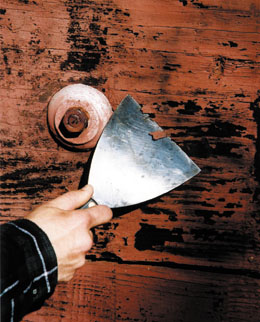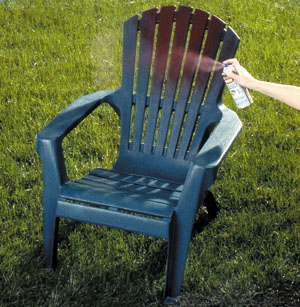How To Repair Stairs Outdor Paint
A fresh coat of paint is 1 of the most inexpensive ways to freshen-up your dwelling house's outside. Just whether you plan to paint wood, masonry, metallic or fifty-fifty plastic, preparing the surface before applying the topcoat is the first critical phase of the project. It may exist a dreary procedure, but taking the time to correctly prep the job volition pay off in smooth, durable coverage sure to last for years.
Paint is basically colored gum. Because it is designed to class a moving picture, its inherent nature is to peel when it can't attach to a surface. Paint will, withal, stick well to substrates that don't shift beneath the pigment. Metal of just about any blazon is an first-class substrate. Aluminum siding is a skilful case; paint can last for years on aluminum. Aluminum even expands and contracts, only the paint holds on. Wood and other "moving" surfaces that contract or aggrandize due to wet or temperature alter may crave some actress preparatory steps to minimize peeling.
Cleaning and Scraping
First, check the label on the tin of paint you intend to apply. It'south a safe bet that somewhere the label reads: "Utilise to a clean, dry out surface." Before priming, brand sure the outside surface of your material is clean — free of clay, grease, mold, mildew or any other droppings.
For previously painted surfaces, kickoff past removing any loose, peeling paint already present. Flat putty knives or "pull" scrapers piece of work well for this. Pull scrapers characteristic shallow U-shaped cut blades that aid cut through old oil paints. Remove as much loose paint as possible, and wear goggles when scraping overhead to go on paint chips out of your eyes. Then wash and rinse the surface. Check the scraped areas once again where the paint meets the bare surface. Probable, there will still exist signs of pigment film lifting slightly from the surface. If so, scrape these areas again.
Some substrates tin can exist sanded polish where the one-time paint meets the bare surface. For maximum paint adhesion on glossy surfaces, scuff-sand the surface before painting. Merely go on in mind, there are some situations where sanding isn't a good idea. Some old, exterior firm paints contain lead. Sanding this type of paint will generate toxic lead dust. If you don't know the history of the paint you lot're removing, you can contact local health officials for information on lead paint testing.
The adjacent stride is to wash the surface. Regular liquid dish soap may piece of work fine, although it does produce a lot of suds. You may opt for a non-soapy detergent such equally trisodium phosphate (TSP) or a TSP substitute to get rid of dirt and grease. Using the soap, rub the entire surface with a sponge or scrub brush to remove all dirt. If mold or mildew is present, use a mildew-removing solution, bachelor at domicile stores like Lowe's and Home Depot. And then quickly rinse with clear water from a standard garden hose to remove the muddy water, and let the surface dry thoroughly earlier priming. Allow porous surfaces such as woods or brick to dry for a minimum of two days before continuing.

Remove any existing loose paint with a pigment scraper and clean the subsurface throughly with water and detergent.
Woods Worries
Wood can exist the toughest material to paint. Its tendency to expand and contract can take a toll on the strongest pigment. And with paint as wood'south merely line of defense, if exposed edges or seams aren't painted, severe rot can develop within simply a few years. All wood surfaces must be primed with an exterior wood primer.
Paint will adhere quite well to wood if the entire forest slice is primed before it's installed. That's why many wood sidings are available factory-primed, which is highly recommended for new homes or room additions.
To seal the wood completely requires painting and priming the cut edges, besides equally the face of the boards, but few carpenters bother to do this. The cut ends are often where end grain is exposed, and this is where information technology is easiest for h2o to enter the wood. The absorbed water can migrate 5 to 6 inches away from the terminate of the board. This is frequently why you run into the edges or bottom portions of trim boards flake. Do what you can to eliminate this kind of h2o intrusion.
Try using standard acrylic latex caulks to seal the end grain. Wipe the caulking with a moist sponge as presently as information technology is applied to produce a make clean, smooth articulation. If painting siding, caulk all joints between the siding and trim boards. Still, do not caulk the bottom border of clapboard siding. That small scissure on clapboard allows the siding to move and allows vapor to escape.
For wood surfaces, Employ a rust-inhibitive primer to any exposed nails. Countersink the nails and fill the holes with exterior spackling compound.
Oil-based primers are excellent choices for wood projects because they penetrate deeply into wood fiber. This seals wood such every bit cedar and redwood that can produce drain stains when coated with water-based products. Primers are a must on bare wood and whatever previously painted surfaces that showroom blisters, flaking or whatever sign of paint erosion.
To accommodate for the movement of wood, information technology helps to use paint with built-in flexibility. Acrylic resins (paint gum) offering the greatest amount of flexibility. These paints resist getting brittle similar older oil-based paints, and they can withstand years of substrate move.
Surface Selections
Unlike substrate materials crave different prep methods. Jobs that involve new physical block, for instance, shouldn't be painted until the mortar has cured for at to the lowest degree xxx days. For a smooth surface on concrete cake, products such as Sherwin-Williams' PrepRite Cake Filler permit the topcoat to be more uniform and unbroken.
Other projects may involve poured concrete, stucco, masonry and cement-composition board. When newly installed, these surfaces must cure for at least 30 days and take no moisture problems before painting. Apply an exterior acrylic masonry primer for these materials.
Physical Floors
Earlier painting concrete floors, perform a moisture exam. Tape a 2-pes square of plastic to the floor and wait virtually 48 hours. If the concrete discolors or there are any visible signs of wet trapped in the plastic, the floor shouldn't be painted. Otherwise, use a degreaser to thoroughly clean the surface. So roughen the surface with a wire brush and acid-based solution to help ensure a strong bond with the paint. A mixture that works well is 1 role hydrochloric acid to one part water. After applying, rinse the floor with water and allow it dry for two to three days. Permit new concrete to cure for at least thirty days prior to painting.
Metals
When it comes to prepping metals for paint, start by cleaning away any corrosion with a wire brush and sandpaper. Metal should be primed the same twenty-four hours it is cleaned. Oil- or alkyd-based metal primers that contain high quantities of rust-inhibitive pigments tend to get the best results when priming rusty steel.
Unfinished galvanized metal or aluminum should exist wiped with a degreasing cleaner, rinsed and dried. There are both water-based and oil-based paints that work well for metals, but be sure to use paints that are compatible with your primer. Nearly manufacturers bespeak what blazon of primer should be used for a particular finish coat, and vice-versa.
At that place are besides special paints available for painting the metal of central heating pipes and radiators. These special paints are designed to stand up to the high temperatures of these areas.
Aluminum and Vinyl Siding
For aluminum siding, first clean the siding with detergent, rinse thoroughly and let dry for several days. Remove any mildew, chalk or other debris; paint will not stick to a chalky surface. Replace whatsoever loose caulk. To prime aluminum siding, leading manufacturers recommend using a thinned metal priming paint. Try a mixture of ane pint of paint thinner to i gallon of high-quality oil-based primer. And consider having the primer tinted to half the forcefulness of the colour of your terminate pigment.
For vinyl siding, follow the same cleaning procedure as aluminum siding. An oxygen bleach solution does a skilful job of removing mildew from vinyl. Oxygen bleach won't harm the vinyl or the plants in your yard. Priming the vinyl siding is not necessary, only remove any rust from metallic areas and coat those with a skilful rust-inhibitive primer.
Vinyl siding will warp from heat buildup. For this reason, very night colors are not recommended. As a full general rule, don't paint vinyl siding any darker than the color of the original siding. And make sure your outside paint is formulated to stick to vinyl siding despite the vinyl's tendency to profoundly aggrandize and contract. Recent advances in paint composition offering new paint options that work keen on vinyl.
Plastic
When the object at manus is plastic, to which paint doesn't hands adhere, new products similar Rust-Oleum'south Specialty Plastic Primer are formulated specifically for paint adhesion and durability on plastic. This gives abode decorators the power to personalize their plastic items with any of hundreds of paint colors, sheens or specialty finishes. Another company, Krylon, offers a new line of plastic finish pigment called Fusion that is designed to bond to plastic without sanding or priming. Available in 16 color choices, Krylon'southward Fusion plastic paint is designed to dry in xv minutes. Both the Rust-Oleum and Krylon products are bachelor in spray-nozzle cans for easy application to irregular surfaces such every bit patio furniture.
Clean the surface of any plastic particular earlier spraying on the primer (or end paint) to provide a tight, adhesive bond betwixt the plastic and topcoat. These advances in paint technology brand bachelor a vast array of options to transform drab plastic planters, backyard chairs or other items into eye-catching accessories.

Plastics? No problem. New products such as Krylon's Fusion line of spray paints make it easy to customize lawn piece of furniture, planetrs and other plastic items.
When to Paint
Weather condition conditions can have a neat bear on on how well paint holds upwards. The worst conditions are extreme heat or cold. Paint needs to chemically bail to the surface information technology is covering. This bonding tin only happen if the solvent (water or mineral spirits) in the pigment evaporates at a deadening or medium pace. Water-based paints used on a brilliant, hot or windy day can consequence in the water evaporating too speedily from the pigment. Plan your painting for libation temperatures and effort to paint areas later on straight sunlight has left them for the day.
The trick to prepping a paint job is to programme alee, to be patient and to consummate these crucial procedures. Don't jump ahead. Sacrifice instant gratification for the sake of long-term satisfaction, and your topcoat will stick around for many moons to come.
Sources
3M, 3M.com
Krylon, krylon.com
Masterchem Industries, KILZ.com
Rust-Oleum, rustoleum.com
Sherwin-Williams, sherwin-williams.com
How To Repair Stairs Outdor Paint,
Source: https://extremehowto.com/prep-steps-for-outdoor-painting/
Posted by: wrightwerighly.blogspot.com


0 Response to "How To Repair Stairs Outdor Paint"
Post a Comment